Strategic Marketing Report: Analysis of Vodafone's Strategies
VerifiedAdded on 2020/01/16
|13
|4332
|174
Report
AI Summary
This report provides a comprehensive analysis of Vodafone's strategic marketing, examining its role in achieving both short-term and long-term goals. It delves into the principles of marketing, the development of marketing strategies, and the interplay between micro and macro environmental factors. The report explores the relationship between corporate and marketing strategies, analyzing decisions at the corporate, business unit, and functional levels. It evaluates approaches to internal and external environmental analysis, including SWOT and PESTLE analyses, and assesses Vodafone's competitive positioning within the telecommunications market. Furthermore, the report examines various business strategies, marketing communication approaches, and the implementation of marketing strategies, including resource allocation and management. The report concludes by summarizing key findings and recommendations for Vodafone's continued success in the competitive telecommunications industry.
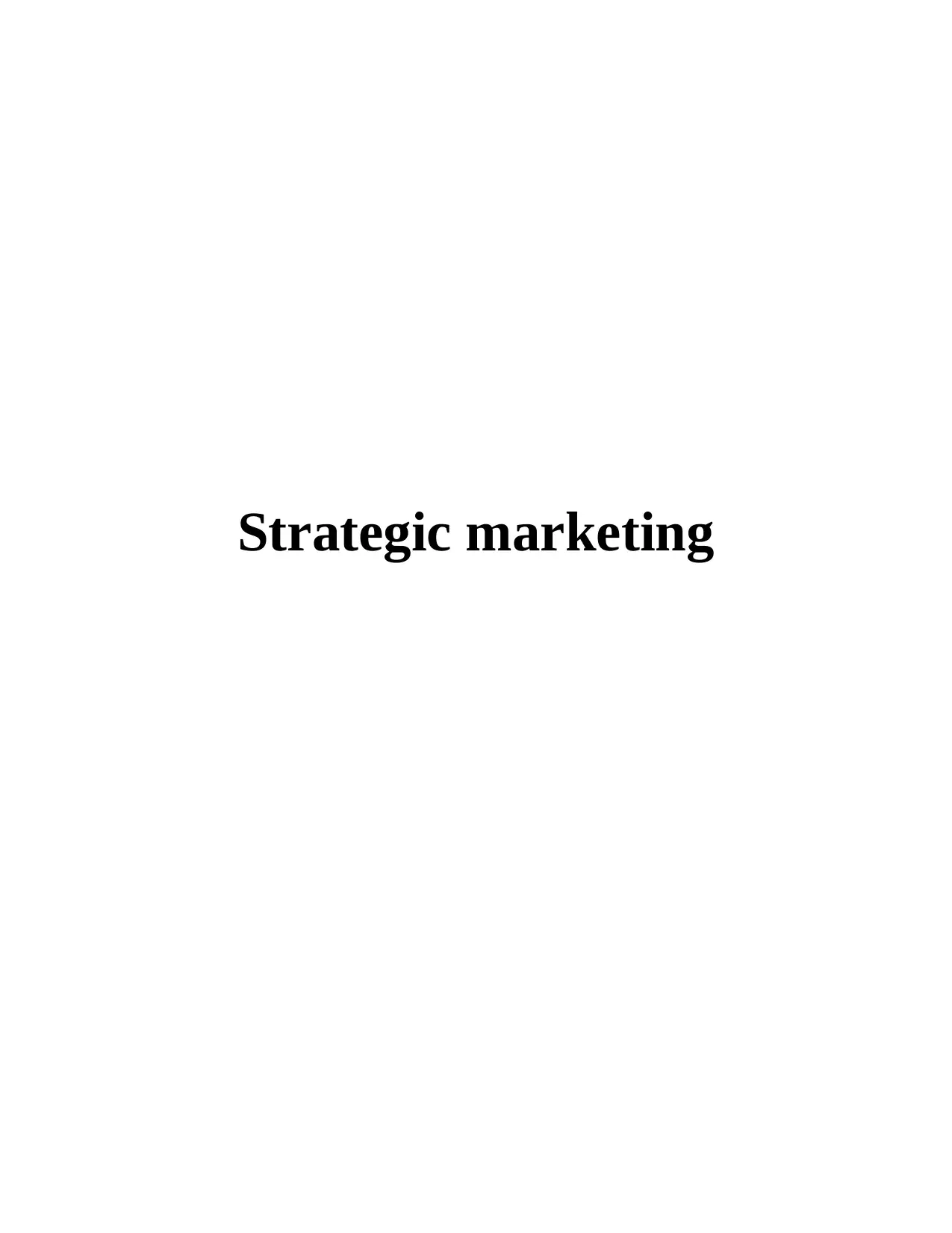
Strategic marketing
Paraphrase This Document
Need a fresh take? Get an instant paraphrase of this document with our AI Paraphraser
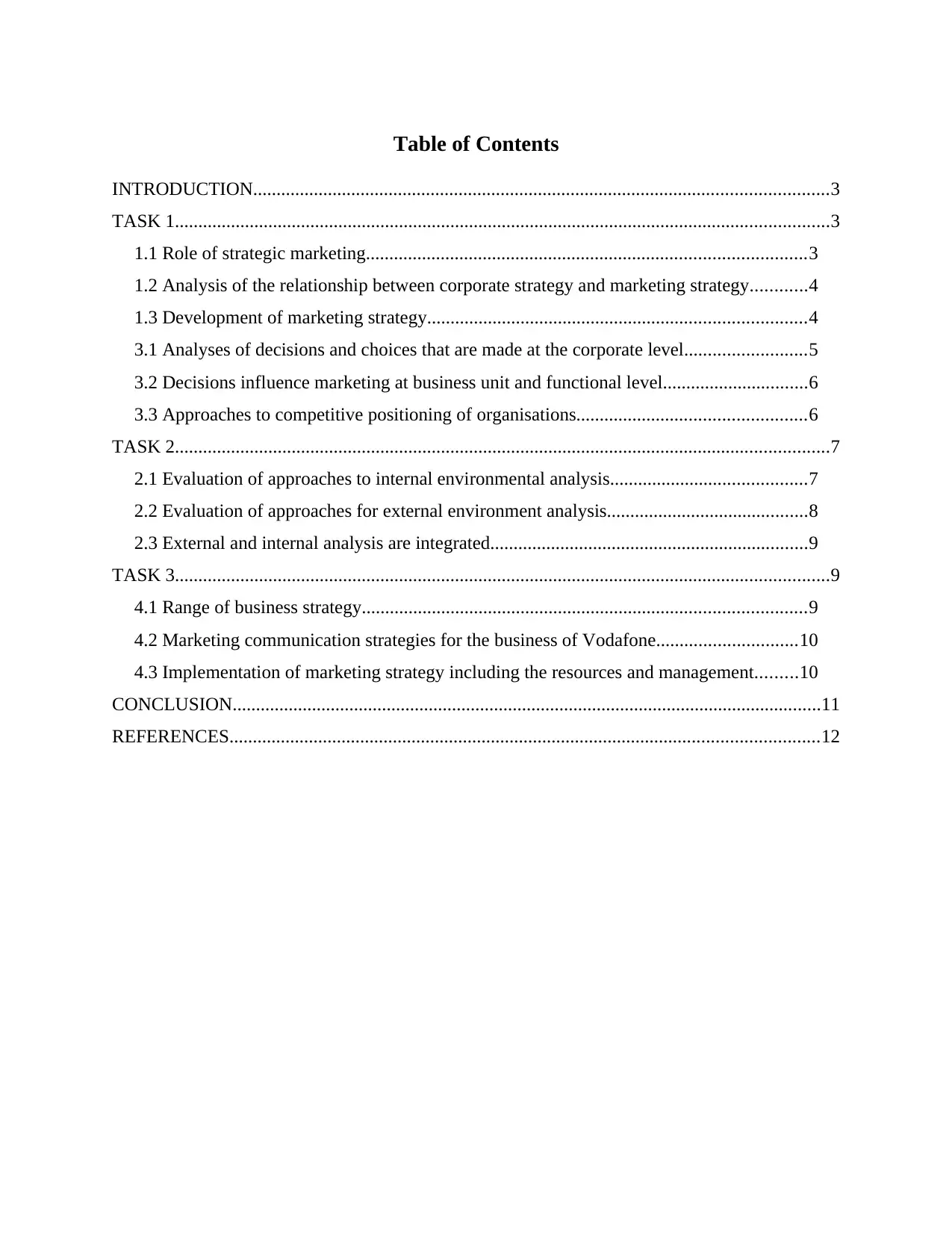
Table of Contents
INTRODUCTION...........................................................................................................................3
TASK 1............................................................................................................................................3
1.1 Role of strategic marketing..............................................................................................3
1.2 Analysis of the relationship between corporate strategy and marketing strategy............4
1.3 Development of marketing strategy.................................................................................4
3.1 Analyses of decisions and choices that are made at the corporate level..........................5
3.2 Decisions influence marketing at business unit and functional level...............................6
3.3 Approaches to competitive positioning of organisations.................................................6
TASK 2............................................................................................................................................7
2.1 Evaluation of approaches to internal environmental analysis..........................................7
2.2 Evaluation of approaches for external environment analysis...........................................8
2.3 External and internal analysis are integrated....................................................................9
TASK 3............................................................................................................................................9
4.1 Range of business strategy...............................................................................................9
4.2 Marketing communication strategies for the business of Vodafone..............................10
4.3 Implementation of marketing strategy including the resources and management.........10
CONCLUSION..............................................................................................................................11
REFERENCES..............................................................................................................................12
INTRODUCTION...........................................................................................................................3
TASK 1............................................................................................................................................3
1.1 Role of strategic marketing..............................................................................................3
1.2 Analysis of the relationship between corporate strategy and marketing strategy............4
1.3 Development of marketing strategy.................................................................................4
3.1 Analyses of decisions and choices that are made at the corporate level..........................5
3.2 Decisions influence marketing at business unit and functional level...............................6
3.3 Approaches to competitive positioning of organisations.................................................6
TASK 2............................................................................................................................................7
2.1 Evaluation of approaches to internal environmental analysis..........................................7
2.2 Evaluation of approaches for external environment analysis...........................................8
2.3 External and internal analysis are integrated....................................................................9
TASK 3............................................................................................................................................9
4.1 Range of business strategy...............................................................................................9
4.2 Marketing communication strategies for the business of Vodafone..............................10
4.3 Implementation of marketing strategy including the resources and management.........10
CONCLUSION..............................................................................................................................11
REFERENCES..............................................................................................................................12
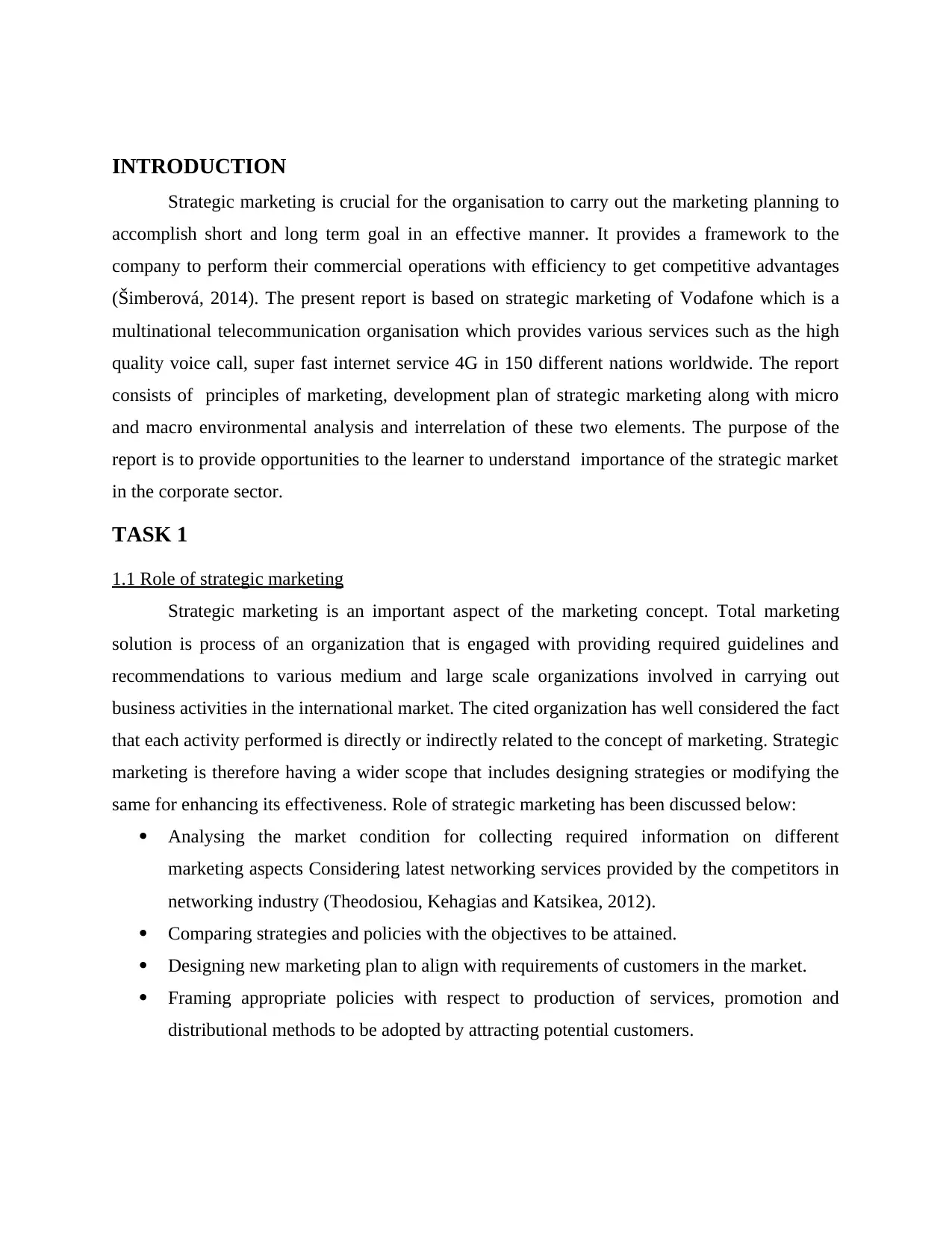
INTRODUCTION
Strategic marketing is crucial for the organisation to carry out the marketing planning to
accomplish short and long term goal in an effective manner. It provides a framework to the
company to perform their commercial operations with efficiency to get competitive advantages
(Šimberová, 2014). The present report is based on strategic marketing of Vodafone which is a
multinational telecommunication organisation which provides various services such as the high
quality voice call, super fast internet service 4G in 150 different nations worldwide. The report
consists of principles of marketing, development plan of strategic marketing along with micro
and macro environmental analysis and interrelation of these two elements. The purpose of the
report is to provide opportunities to the learner to understand importance of the strategic market
in the corporate sector.
TASK 1
1.1 Role of strategic marketing
Strategic marketing is an important aspect of the marketing concept. Total marketing
solution is process of an organization that is engaged with providing required guidelines and
recommendations to various medium and large scale organizations involved in carrying out
business activities in the international market. The cited organization has well considered the fact
that each activity performed is directly or indirectly related to the concept of marketing. Strategic
marketing is therefore having a wider scope that includes designing strategies or modifying the
same for enhancing its effectiveness. Role of strategic marketing has been discussed below:
Analysing the market condition for collecting required information on different
marketing aspects Considering latest networking services provided by the competitors in
networking industry (Theodosiou, Kehagias and Katsikea, 2012).
Comparing strategies and policies with the objectives to be attained.
Designing new marketing plan to align with requirements of customers in the market.
Framing appropriate policies with respect to production of services, promotion and
distributional methods to be adopted by attracting potential customers.
Strategic marketing is crucial for the organisation to carry out the marketing planning to
accomplish short and long term goal in an effective manner. It provides a framework to the
company to perform their commercial operations with efficiency to get competitive advantages
(Šimberová, 2014). The present report is based on strategic marketing of Vodafone which is a
multinational telecommunication organisation which provides various services such as the high
quality voice call, super fast internet service 4G in 150 different nations worldwide. The report
consists of principles of marketing, development plan of strategic marketing along with micro
and macro environmental analysis and interrelation of these two elements. The purpose of the
report is to provide opportunities to the learner to understand importance of the strategic market
in the corporate sector.
TASK 1
1.1 Role of strategic marketing
Strategic marketing is an important aspect of the marketing concept. Total marketing
solution is process of an organization that is engaged with providing required guidelines and
recommendations to various medium and large scale organizations involved in carrying out
business activities in the international market. The cited organization has well considered the fact
that each activity performed is directly or indirectly related to the concept of marketing. Strategic
marketing is therefore having a wider scope that includes designing strategies or modifying the
same for enhancing its effectiveness. Role of strategic marketing has been discussed below:
Analysing the market condition for collecting required information on different
marketing aspects Considering latest networking services provided by the competitors in
networking industry (Theodosiou, Kehagias and Katsikea, 2012).
Comparing strategies and policies with the objectives to be attained.
Designing new marketing plan to align with requirements of customers in the market.
Framing appropriate policies with respect to production of services, promotion and
distributional methods to be adopted by attracting potential customers.
⊘ This is a preview!⊘
Do you want full access?
Subscribe today to unlock all pages.

Trusted by 1+ million students worldwide
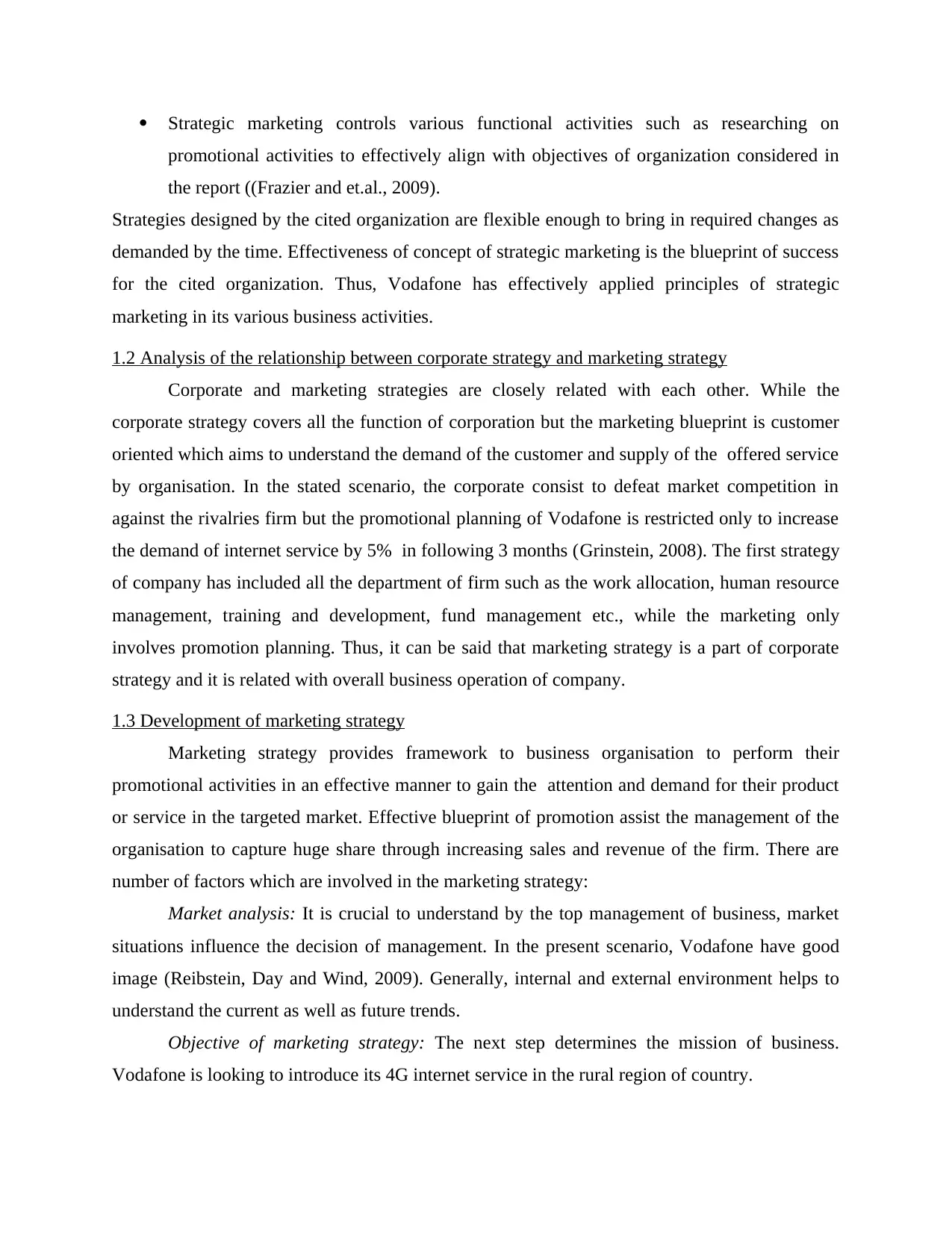
Strategic marketing controls various functional activities such as researching on
promotional activities to effectively align with objectives of organization considered in
the report ((Frazier and et.al., 2009).
Strategies designed by the cited organization are flexible enough to bring in required changes as
demanded by the time. Effectiveness of concept of strategic marketing is the blueprint of success
for the cited organization. Thus, Vodafone has effectively applied principles of strategic
marketing in its various business activities.
1.2 Analysis of the relationship between corporate strategy and marketing strategy
Corporate and marketing strategies are closely related with each other. While the
corporate strategy covers all the function of corporation but the marketing blueprint is customer
oriented which aims to understand the demand of the customer and supply of the offered service
by organisation. In the stated scenario, the corporate consist to defeat market competition in
against the rivalries firm but the promotional planning of Vodafone is restricted only to increase
the demand of internet service by 5% in following 3 months (Grinstein, 2008). The first strategy
of company has included all the department of firm such as the work allocation, human resource
management, training and development, fund management etc., while the marketing only
involves promotion planning. Thus, it can be said that marketing strategy is a part of corporate
strategy and it is related with overall business operation of company.
1.3 Development of marketing strategy
Marketing strategy provides framework to business organisation to perform their
promotional activities in an effective manner to gain the attention and demand for their product
or service in the targeted market. Effective blueprint of promotion assist the management of the
organisation to capture huge share through increasing sales and revenue of the firm. There are
number of factors which are involved in the marketing strategy:
Market analysis: It is crucial to understand by the top management of business, market
situations influence the decision of management. In the present scenario, Vodafone have good
image (Reibstein, Day and Wind, 2009). Generally, internal and external environment helps to
understand the current as well as future trends.
Objective of marketing strategy: The next step determines the mission of business.
Vodafone is looking to introduce its 4G internet service in the rural region of country.
promotional activities to effectively align with objectives of organization considered in
the report ((Frazier and et.al., 2009).
Strategies designed by the cited organization are flexible enough to bring in required changes as
demanded by the time. Effectiveness of concept of strategic marketing is the blueprint of success
for the cited organization. Thus, Vodafone has effectively applied principles of strategic
marketing in its various business activities.
1.2 Analysis of the relationship between corporate strategy and marketing strategy
Corporate and marketing strategies are closely related with each other. While the
corporate strategy covers all the function of corporation but the marketing blueprint is customer
oriented which aims to understand the demand of the customer and supply of the offered service
by organisation. In the stated scenario, the corporate consist to defeat market competition in
against the rivalries firm but the promotional planning of Vodafone is restricted only to increase
the demand of internet service by 5% in following 3 months (Grinstein, 2008). The first strategy
of company has included all the department of firm such as the work allocation, human resource
management, training and development, fund management etc., while the marketing only
involves promotion planning. Thus, it can be said that marketing strategy is a part of corporate
strategy and it is related with overall business operation of company.
1.3 Development of marketing strategy
Marketing strategy provides framework to business organisation to perform their
promotional activities in an effective manner to gain the attention and demand for their product
or service in the targeted market. Effective blueprint of promotion assist the management of the
organisation to capture huge share through increasing sales and revenue of the firm. There are
number of factors which are involved in the marketing strategy:
Market analysis: It is crucial to understand by the top management of business, market
situations influence the decision of management. In the present scenario, Vodafone have good
image (Reibstein, Day and Wind, 2009). Generally, internal and external environment helps to
understand the current as well as future trends.
Objective of marketing strategy: The next step determines the mission of business.
Vodafone is looking to introduce its 4G internet service in the rural region of country.
Paraphrase This Document
Need a fresh take? Get an instant paraphrase of this document with our AI Paraphraser
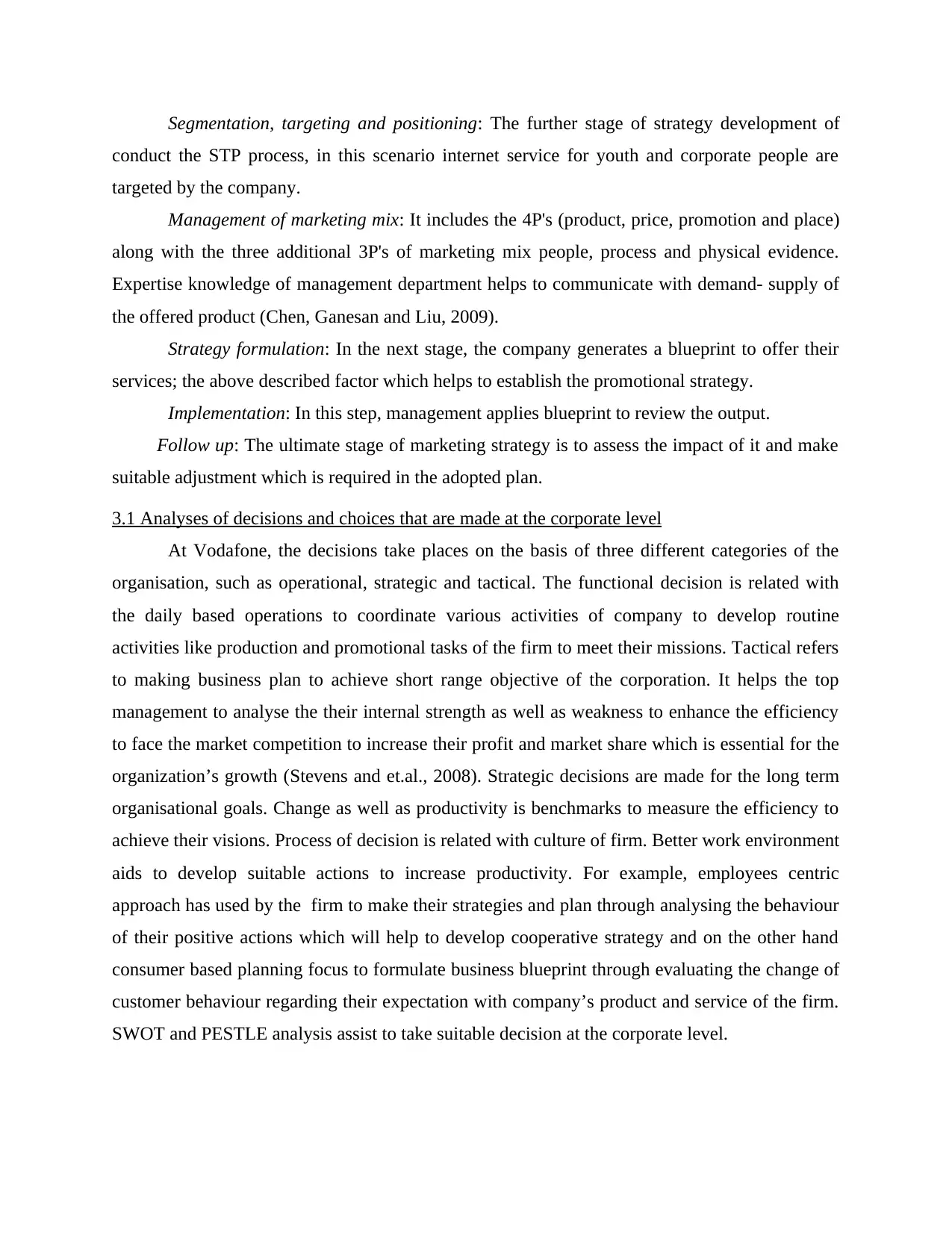
Segmentation, targeting and positioning: The further stage of strategy development of
conduct the STP process, in this scenario internet service for youth and corporate people are
targeted by the company.
Management of marketing mix: It includes the 4P's (product, price, promotion and place)
along with the three additional 3P's of marketing mix people, process and physical evidence.
Expertise knowledge of management department helps to communicate with demand- supply of
the offered product (Chen, Ganesan and Liu, 2009).
Strategy formulation: In the next stage, the company generates a blueprint to offer their
services; the above described factor which helps to establish the promotional strategy.
Implementation: In this step, management applies blueprint to review the output.
Follow up: The ultimate stage of marketing strategy is to assess the impact of it and make
suitable adjustment which is required in the adopted plan.
3.1 Analyses of decisions and choices that are made at the corporate level
At Vodafone, the decisions take places on the basis of three different categories of the
organisation, such as operational, strategic and tactical. The functional decision is related with
the daily based operations to coordinate various activities of company to develop routine
activities like production and promotional tasks of the firm to meet their missions. Tactical refers
to making business plan to achieve short range objective of the corporation. It helps the top
management to analyse the their internal strength as well as weakness to enhance the efficiency
to face the market competition to increase their profit and market share which is essential for the
organization’s growth (Stevens and et.al., 2008). Strategic decisions are made for the long term
organisational goals. Change as well as productivity is benchmarks to measure the efficiency to
achieve their visions. Process of decision is related with culture of firm. Better work environment
aids to develop suitable actions to increase productivity. For example, employees centric
approach has used by the firm to make their strategies and plan through analysing the behaviour
of their positive actions which will help to develop cooperative strategy and on the other hand
consumer based planning focus to formulate business blueprint through evaluating the change of
customer behaviour regarding their expectation with company’s product and service of the firm.
SWOT and PESTLE analysis assist to take suitable decision at the corporate level.
conduct the STP process, in this scenario internet service for youth and corporate people are
targeted by the company.
Management of marketing mix: It includes the 4P's (product, price, promotion and place)
along with the three additional 3P's of marketing mix people, process and physical evidence.
Expertise knowledge of management department helps to communicate with demand- supply of
the offered product (Chen, Ganesan and Liu, 2009).
Strategy formulation: In the next stage, the company generates a blueprint to offer their
services; the above described factor which helps to establish the promotional strategy.
Implementation: In this step, management applies blueprint to review the output.
Follow up: The ultimate stage of marketing strategy is to assess the impact of it and make
suitable adjustment which is required in the adopted plan.
3.1 Analyses of decisions and choices that are made at the corporate level
At Vodafone, the decisions take places on the basis of three different categories of the
organisation, such as operational, strategic and tactical. The functional decision is related with
the daily based operations to coordinate various activities of company to develop routine
activities like production and promotional tasks of the firm to meet their missions. Tactical refers
to making business plan to achieve short range objective of the corporation. It helps the top
management to analyse the their internal strength as well as weakness to enhance the efficiency
to face the market competition to increase their profit and market share which is essential for the
organization’s growth (Stevens and et.al., 2008). Strategic decisions are made for the long term
organisational goals. Change as well as productivity is benchmarks to measure the efficiency to
achieve their visions. Process of decision is related with culture of firm. Better work environment
aids to develop suitable actions to increase productivity. For example, employees centric
approach has used by the firm to make their strategies and plan through analysing the behaviour
of their positive actions which will help to develop cooperative strategy and on the other hand
consumer based planning focus to formulate business blueprint through evaluating the change of
customer behaviour regarding their expectation with company’s product and service of the firm.
SWOT and PESTLE analysis assist to take suitable decision at the corporate level.
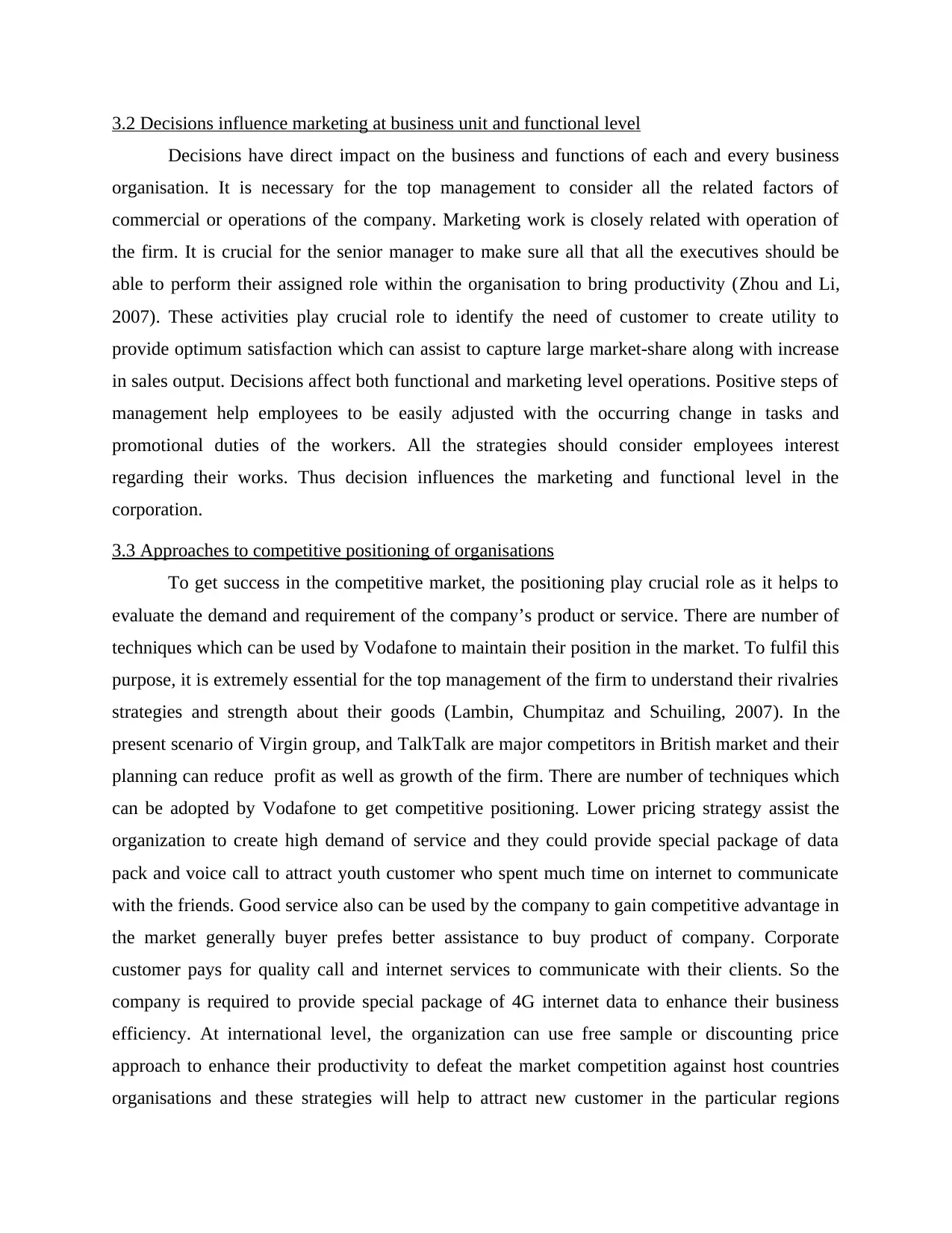
3.2 Decisions influence marketing at business unit and functional level
Decisions have direct impact on the business and functions of each and every business
organisation. It is necessary for the top management to consider all the related factors of
commercial or operations of the company. Marketing work is closely related with operation of
the firm. It is crucial for the senior manager to make sure all that all the executives should be
able to perform their assigned role within the organisation to bring productivity (Zhou and Li,
2007). These activities play crucial role to identify the need of customer to create utility to
provide optimum satisfaction which can assist to capture large market-share along with increase
in sales output. Decisions affect both functional and marketing level operations. Positive steps of
management help employees to be easily adjusted with the occurring change in tasks and
promotional duties of the workers. All the strategies should consider employees interest
regarding their works. Thus decision influences the marketing and functional level in the
corporation.
3.3 Approaches to competitive positioning of organisations
To get success in the competitive market, the positioning play crucial role as it helps to
evaluate the demand and requirement of the company’s product or service. There are number of
techniques which can be used by Vodafone to maintain their position in the market. To fulfil this
purpose, it is extremely essential for the top management of the firm to understand their rivalries
strategies and strength about their goods (Lambin, Chumpitaz and Schuiling, 2007). In the
present scenario of Virgin group, and TalkTalk are major competitors in British market and their
planning can reduce profit as well as growth of the firm. There are number of techniques which
can be adopted by Vodafone to get competitive positioning. Lower pricing strategy assist the
organization to create high demand of service and they could provide special package of data
pack and voice call to attract youth customer who spent much time on internet to communicate
with the friends. Good service also can be used by the company to gain competitive advantage in
the market generally buyer prefes better assistance to buy product of company. Corporate
customer pays for quality call and internet services to communicate with their clients. So the
company is required to provide special package of 4G internet data to enhance their business
efficiency. At international level, the organization can use free sample or discounting price
approach to enhance their productivity to defeat the market competition against host countries
organisations and these strategies will help to attract new customer in the particular regions
Decisions have direct impact on the business and functions of each and every business
organisation. It is necessary for the top management to consider all the related factors of
commercial or operations of the company. Marketing work is closely related with operation of
the firm. It is crucial for the senior manager to make sure all that all the executives should be
able to perform their assigned role within the organisation to bring productivity (Zhou and Li,
2007). These activities play crucial role to identify the need of customer to create utility to
provide optimum satisfaction which can assist to capture large market-share along with increase
in sales output. Decisions affect both functional and marketing level operations. Positive steps of
management help employees to be easily adjusted with the occurring change in tasks and
promotional duties of the workers. All the strategies should consider employees interest
regarding their works. Thus decision influences the marketing and functional level in the
corporation.
3.3 Approaches to competitive positioning of organisations
To get success in the competitive market, the positioning play crucial role as it helps to
evaluate the demand and requirement of the company’s product or service. There are number of
techniques which can be used by Vodafone to maintain their position in the market. To fulfil this
purpose, it is extremely essential for the top management of the firm to understand their rivalries
strategies and strength about their goods (Lambin, Chumpitaz and Schuiling, 2007). In the
present scenario of Virgin group, and TalkTalk are major competitors in British market and their
planning can reduce profit as well as growth of the firm. There are number of techniques which
can be adopted by Vodafone to get competitive positioning. Lower pricing strategy assist the
organization to create high demand of service and they could provide special package of data
pack and voice call to attract youth customer who spent much time on internet to communicate
with the friends. Good service also can be used by the company to gain competitive advantage in
the market generally buyer prefes better assistance to buy product of company. Corporate
customer pays for quality call and internet services to communicate with their clients. So the
company is required to provide special package of 4G internet data to enhance their business
efficiency. At international level, the organization can use free sample or discounting price
approach to enhance their productivity to defeat the market competition against host countries
organisations and these strategies will help to attract new customer in the particular regions
⊘ This is a preview!⊘
Do you want full access?
Subscribe today to unlock all pages.

Trusted by 1+ million students worldwide
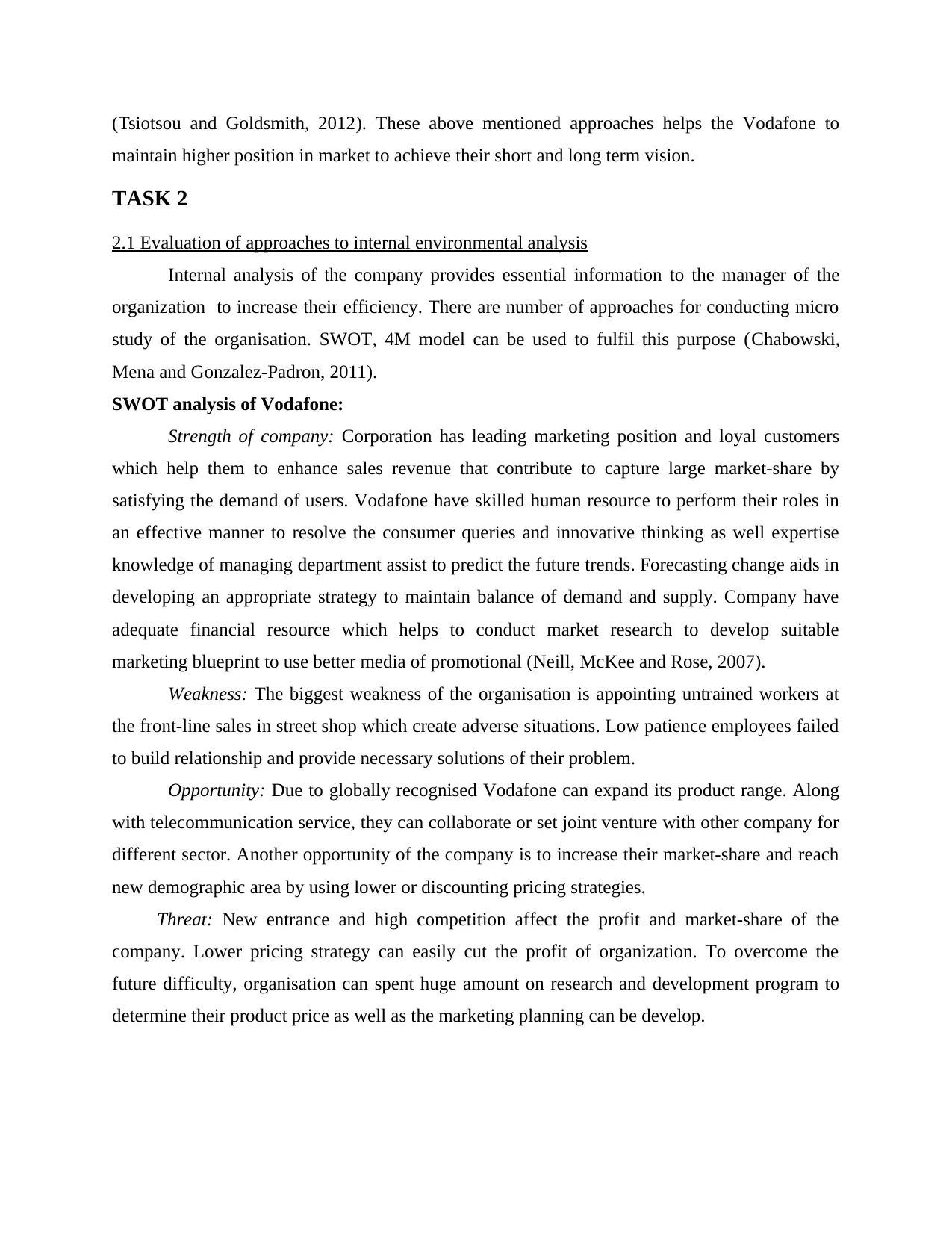
(Tsiotsou and Goldsmith, 2012). These above mentioned approaches helps the Vodafone to
maintain higher position in market to achieve their short and long term vision.
TASK 2
2.1 Evaluation of approaches to internal environmental analysis
Internal analysis of the company provides essential information to the manager of the
organization to increase their efficiency. There are number of approaches for conducting micro
study of the organisation. SWOT, 4M model can be used to fulfil this purpose (Chabowski,
Mena and Gonzalez-Padron, 2011).
SWOT analysis of Vodafone:
Strength of company: Corporation has leading marketing position and loyal customers
which help them to enhance sales revenue that contribute to capture large market-share by
satisfying the demand of users. Vodafone have skilled human resource to perform their roles in
an effective manner to resolve the consumer queries and innovative thinking as well expertise
knowledge of managing department assist to predict the future trends. Forecasting change aids in
developing an appropriate strategy to maintain balance of demand and supply. Company have
adequate financial resource which helps to conduct market research to develop suitable
marketing blueprint to use better media of promotional (Neill, McKee and Rose, 2007).
Weakness: The biggest weakness of the organisation is appointing untrained workers at
the front-line sales in street shop which create adverse situations. Low patience employees failed
to build relationship and provide necessary solutions of their problem.
Opportunity: Due to globally recognised Vodafone can expand its product range. Along
with telecommunication service, they can collaborate or set joint venture with other company for
different sector. Another opportunity of the company is to increase their market-share and reach
new demographic area by using lower or discounting pricing strategies.
Threat: New entrance and high competition affect the profit and market-share of the
company. Lower pricing strategy can easily cut the profit of organization. To overcome the
future difficulty, organisation can spent huge amount on research and development program to
determine their product price as well as the marketing planning can be develop.
maintain higher position in market to achieve their short and long term vision.
TASK 2
2.1 Evaluation of approaches to internal environmental analysis
Internal analysis of the company provides essential information to the manager of the
organization to increase their efficiency. There are number of approaches for conducting micro
study of the organisation. SWOT, 4M model can be used to fulfil this purpose (Chabowski,
Mena and Gonzalez-Padron, 2011).
SWOT analysis of Vodafone:
Strength of company: Corporation has leading marketing position and loyal customers
which help them to enhance sales revenue that contribute to capture large market-share by
satisfying the demand of users. Vodafone have skilled human resource to perform their roles in
an effective manner to resolve the consumer queries and innovative thinking as well expertise
knowledge of managing department assist to predict the future trends. Forecasting change aids in
developing an appropriate strategy to maintain balance of demand and supply. Company have
adequate financial resource which helps to conduct market research to develop suitable
marketing blueprint to use better media of promotional (Neill, McKee and Rose, 2007).
Weakness: The biggest weakness of the organisation is appointing untrained workers at
the front-line sales in street shop which create adverse situations. Low patience employees failed
to build relationship and provide necessary solutions of their problem.
Opportunity: Due to globally recognised Vodafone can expand its product range. Along
with telecommunication service, they can collaborate or set joint venture with other company for
different sector. Another opportunity of the company is to increase their market-share and reach
new demographic area by using lower or discounting pricing strategies.
Threat: New entrance and high competition affect the profit and market-share of the
company. Lower pricing strategy can easily cut the profit of organization. To overcome the
future difficulty, organisation can spent huge amount on research and development program to
determine their product price as well as the marketing planning can be develop.
Paraphrase This Document
Need a fresh take? Get an instant paraphrase of this document with our AI Paraphraser
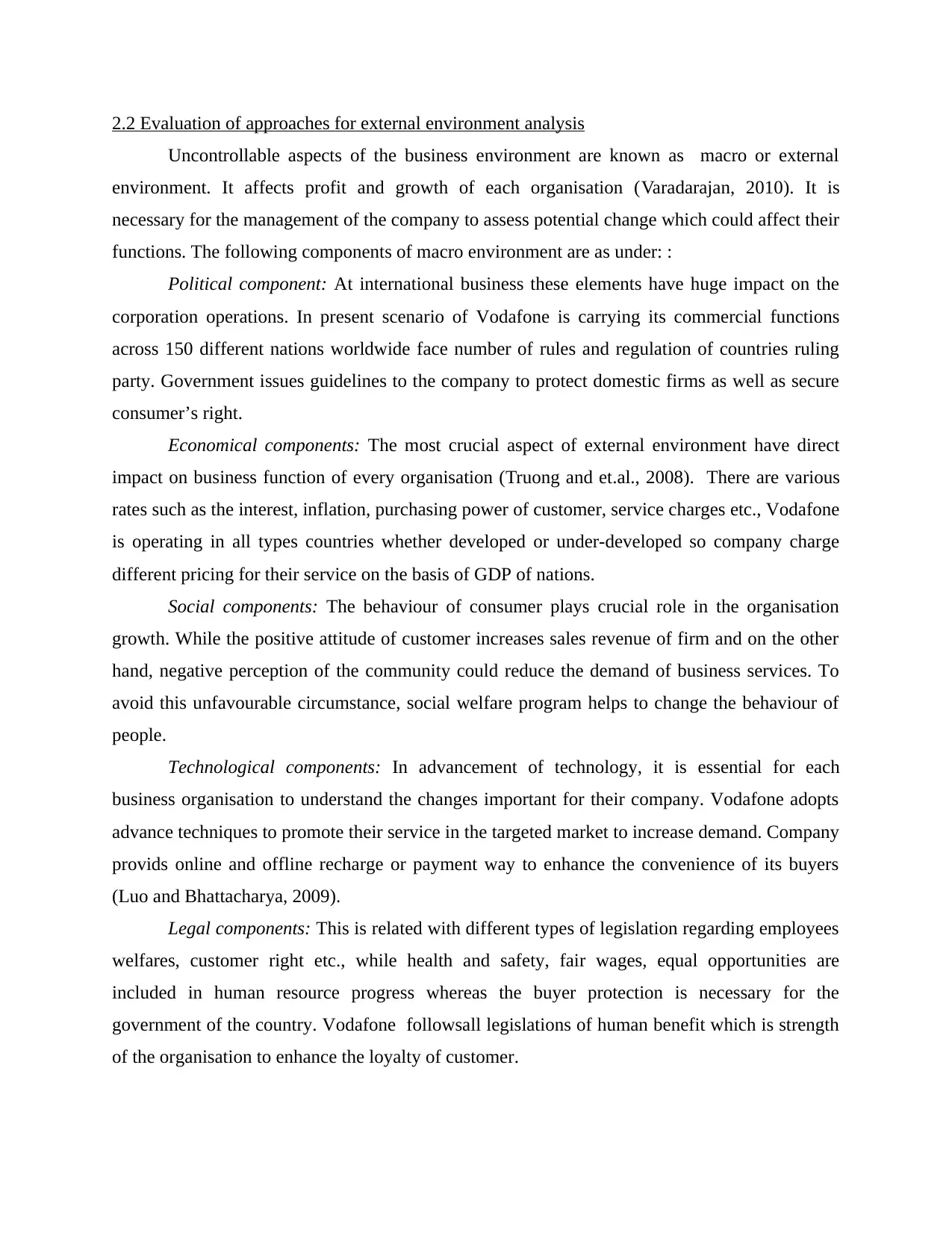
2.2 Evaluation of approaches for external environment analysis
Uncontrollable aspects of the business environment are known as macro or external
environment. It affects profit and growth of each organisation (Varadarajan, 2010). It is
necessary for the management of the company to assess potential change which could affect their
functions. The following components of macro environment are as under: :
Political component: At international business these elements have huge impact on the
corporation operations. In present scenario of Vodafone is carrying its commercial functions
across 150 different nations worldwide face number of rules and regulation of countries ruling
party. Government issues guidelines to the company to protect domestic firms as well as secure
consumer’s right.
Economical components: The most crucial aspect of external environment have direct
impact on business function of every organisation (Truong and et.al., 2008). There are various
rates such as the interest, inflation, purchasing power of customer, service charges etc., Vodafone
is operating in all types countries whether developed or under-developed so company charge
different pricing for their service on the basis of GDP of nations.
Social components: The behaviour of consumer plays crucial role in the organisation
growth. While the positive attitude of customer increases sales revenue of firm and on the other
hand, negative perception of the community could reduce the demand of business services. To
avoid this unfavourable circumstance, social welfare program helps to change the behaviour of
people.
Technological components: In advancement of technology, it is essential for each
business organisation to understand the changes important for their company. Vodafone adopts
advance techniques to promote their service in the targeted market to increase demand. Company
provids online and offline recharge or payment way to enhance the convenience of its buyers
(Luo and Bhattacharya, 2009).
Legal components: This is related with different types of legislation regarding employees
welfares, customer right etc., while health and safety, fair wages, equal opportunities are
included in human resource progress whereas the buyer protection is necessary for the
government of the country. Vodafone followsall legislations of human benefit which is strength
of the organisation to enhance the loyalty of customer.
Uncontrollable aspects of the business environment are known as macro or external
environment. It affects profit and growth of each organisation (Varadarajan, 2010). It is
necessary for the management of the company to assess potential change which could affect their
functions. The following components of macro environment are as under: :
Political component: At international business these elements have huge impact on the
corporation operations. In present scenario of Vodafone is carrying its commercial functions
across 150 different nations worldwide face number of rules and regulation of countries ruling
party. Government issues guidelines to the company to protect domestic firms as well as secure
consumer’s right.
Economical components: The most crucial aspect of external environment have direct
impact on business function of every organisation (Truong and et.al., 2008). There are various
rates such as the interest, inflation, purchasing power of customer, service charges etc., Vodafone
is operating in all types countries whether developed or under-developed so company charge
different pricing for their service on the basis of GDP of nations.
Social components: The behaviour of consumer plays crucial role in the organisation
growth. While the positive attitude of customer increases sales revenue of firm and on the other
hand, negative perception of the community could reduce the demand of business services. To
avoid this unfavourable circumstance, social welfare program helps to change the behaviour of
people.
Technological components: In advancement of technology, it is essential for each
business organisation to understand the changes important for their company. Vodafone adopts
advance techniques to promote their service in the targeted market to increase demand. Company
provids online and offline recharge or payment way to enhance the convenience of its buyers
(Luo and Bhattacharya, 2009).
Legal components: This is related with different types of legislation regarding employees
welfares, customer right etc., while health and safety, fair wages, equal opportunities are
included in human resource progress whereas the buyer protection is necessary for the
government of the country. Vodafone followsall legislations of human benefit which is strength
of the organisation to enhance the loyalty of customer.
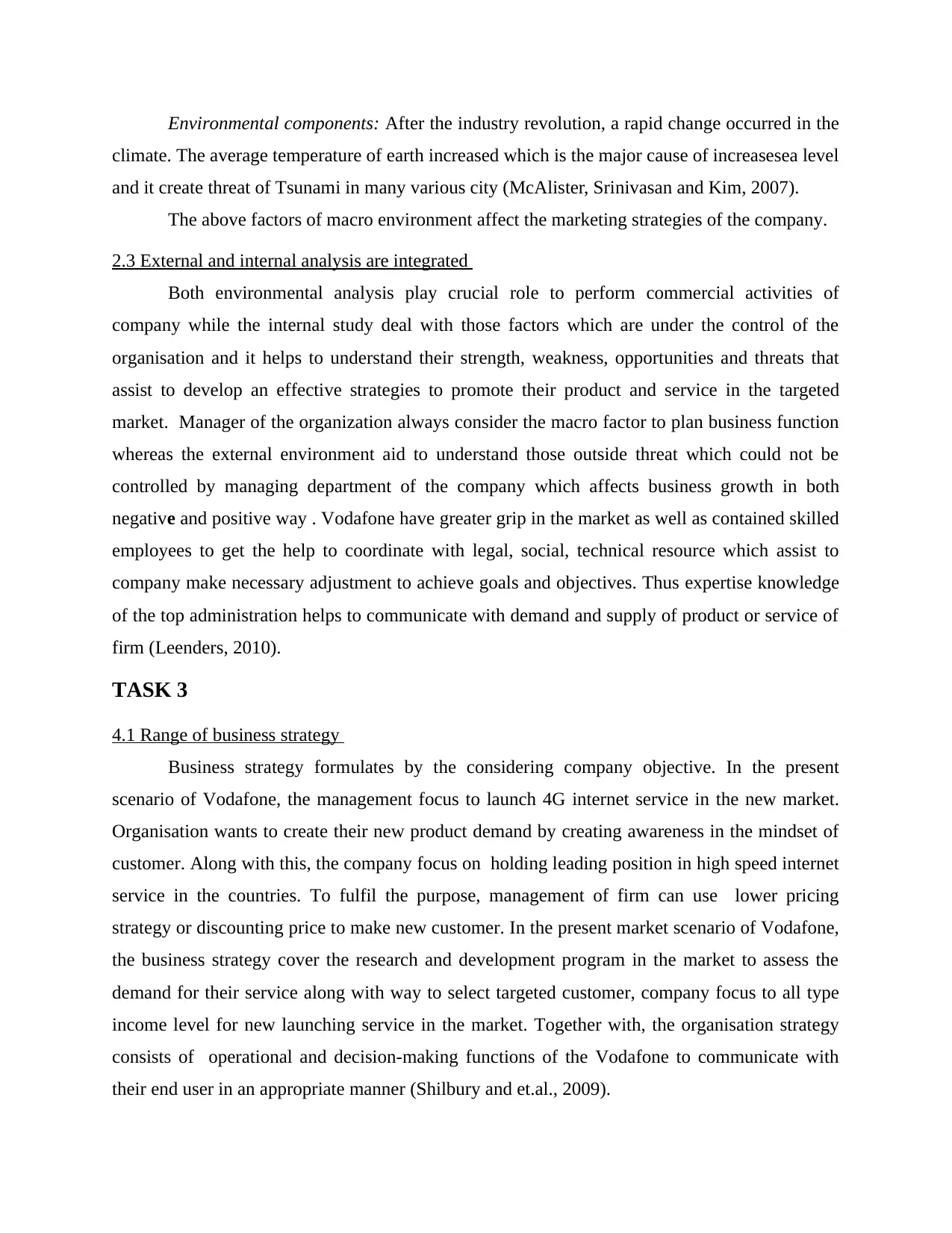
Environmental components: After the industry revolution, a rapid change occurred in the
climate. The average temperature of earth increased which is the major cause of increasesea level
and it create threat of Tsunami in many various city (McAlister, Srinivasan and Kim, 2007).
The above factors of macro environment affect the marketing strategies of the company.
2.3 External and internal analysis are integrated
Both environmental analysis play crucial role to perform commercial activities of
company while the internal study deal with those factors which are under the control of the
organisation and it helps to understand their strength, weakness, opportunities and threats that
assist to develop an effective strategies to promote their product and service in the targeted
market. Manager of the organization always consider the macro factor to plan business function
whereas the external environment aid to understand those outside threat which could not be
controlled by managing department of the company which affects business growth in both
negative and positive way . Vodafone have greater grip in the market as well as contained skilled
employees to get the help to coordinate with legal, social, technical resource which assist to
company make necessary adjustment to achieve goals and objectives. Thus expertise knowledge
of the top administration helps to communicate with demand and supply of product or service of
firm (Leenders, 2010).
TASK 3
4.1 Range of business strategy
Business strategy formulates by the considering company objective. In the present
scenario of Vodafone, the management focus to launch 4G internet service in the new market.
Organisation wants to create their new product demand by creating awareness in the mindset of
customer. Along with this, the company focus on holding leading position in high speed internet
service in the countries. To fulfil the purpose, management of firm can use lower pricing
strategy or discounting price to make new customer. In the present market scenario of Vodafone,
the business strategy cover the research and development program in the market to assess the
demand for their service along with way to select targeted customer, company focus to all type
income level for new launching service in the market. Together with, the organisation strategy
consists of operational and decision-making functions of the Vodafone to communicate with
their end user in an appropriate manner (Shilbury and et.al., 2009).
climate. The average temperature of earth increased which is the major cause of increasesea level
and it create threat of Tsunami in many various city (McAlister, Srinivasan and Kim, 2007).
The above factors of macro environment affect the marketing strategies of the company.
2.3 External and internal analysis are integrated
Both environmental analysis play crucial role to perform commercial activities of
company while the internal study deal with those factors which are under the control of the
organisation and it helps to understand their strength, weakness, opportunities and threats that
assist to develop an effective strategies to promote their product and service in the targeted
market. Manager of the organization always consider the macro factor to plan business function
whereas the external environment aid to understand those outside threat which could not be
controlled by managing department of the company which affects business growth in both
negative and positive way . Vodafone have greater grip in the market as well as contained skilled
employees to get the help to coordinate with legal, social, technical resource which assist to
company make necessary adjustment to achieve goals and objectives. Thus expertise knowledge
of the top administration helps to communicate with demand and supply of product or service of
firm (Leenders, 2010).
TASK 3
4.1 Range of business strategy
Business strategy formulates by the considering company objective. In the present
scenario of Vodafone, the management focus to launch 4G internet service in the new market.
Organisation wants to create their new product demand by creating awareness in the mindset of
customer. Along with this, the company focus on holding leading position in high speed internet
service in the countries. To fulfil the purpose, management of firm can use lower pricing
strategy or discounting price to make new customer. In the present market scenario of Vodafone,
the business strategy cover the research and development program in the market to assess the
demand for their service along with way to select targeted customer, company focus to all type
income level for new launching service in the market. Together with, the organisation strategy
consists of operational and decision-making functions of the Vodafone to communicate with
their end user in an appropriate manner (Shilbury and et.al., 2009).
⊘ This is a preview!⊘
Do you want full access?
Subscribe today to unlock all pages.

Trusted by 1+ million students worldwide
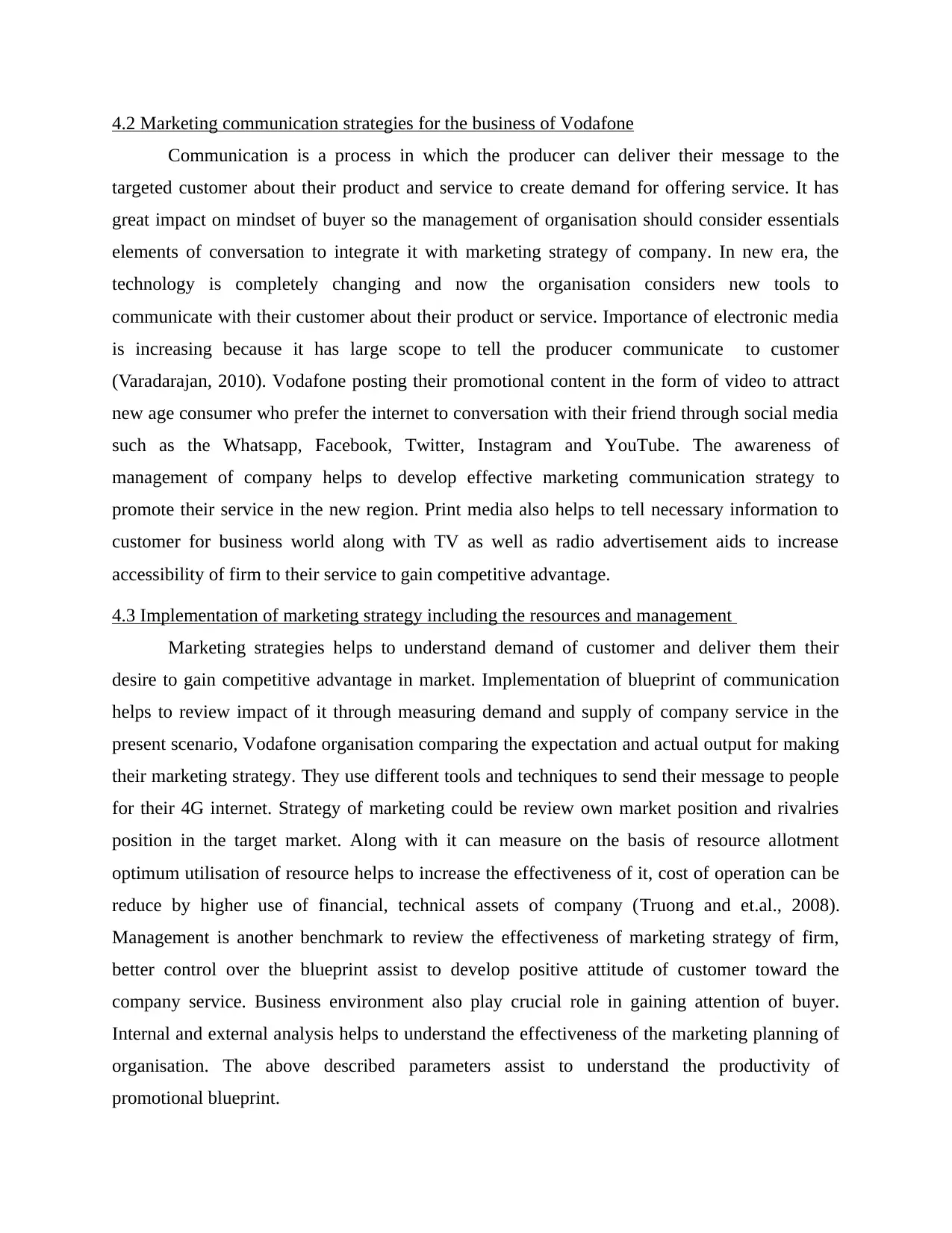
4.2 Marketing communication strategies for the business of Vodafone
Communication is a process in which the producer can deliver their message to the
targeted customer about their product and service to create demand for offering service. It has
great impact on mindset of buyer so the management of organisation should consider essentials
elements of conversation to integrate it with marketing strategy of company. In new era, the
technology is completely changing and now the organisation considers new tools to
communicate with their customer about their product or service. Importance of electronic media
is increasing because it has large scope to tell the producer communicate to customer
(Varadarajan, 2010). Vodafone posting their promotional content in the form of video to attract
new age consumer who prefer the internet to conversation with their friend through social media
such as the Whatsapp, Facebook, Twitter, Instagram and YouTube. The awareness of
management of company helps to develop effective marketing communication strategy to
promote their service in the new region. Print media also helps to tell necessary information to
customer for business world along with TV as well as radio advertisement aids to increase
accessibility of firm to their service to gain competitive advantage.
4.3 Implementation of marketing strategy including the resources and management
Marketing strategies helps to understand demand of customer and deliver them their
desire to gain competitive advantage in market. Implementation of blueprint of communication
helps to review impact of it through measuring demand and supply of company service in the
present scenario, Vodafone organisation comparing the expectation and actual output for making
their marketing strategy. They use different tools and techniques to send their message to people
for their 4G internet. Strategy of marketing could be review own market position and rivalries
position in the target market. Along with it can measure on the basis of resource allotment
optimum utilisation of resource helps to increase the effectiveness of it, cost of operation can be
reduce by higher use of financial, technical assets of company (Truong and et.al., 2008).
Management is another benchmark to review the effectiveness of marketing strategy of firm,
better control over the blueprint assist to develop positive attitude of customer toward the
company service. Business environment also play crucial role in gaining attention of buyer.
Internal and external analysis helps to understand the effectiveness of the marketing planning of
organisation. The above described parameters assist to understand the productivity of
promotional blueprint.
Communication is a process in which the producer can deliver their message to the
targeted customer about their product and service to create demand for offering service. It has
great impact on mindset of buyer so the management of organisation should consider essentials
elements of conversation to integrate it with marketing strategy of company. In new era, the
technology is completely changing and now the organisation considers new tools to
communicate with their customer about their product or service. Importance of electronic media
is increasing because it has large scope to tell the producer communicate to customer
(Varadarajan, 2010). Vodafone posting their promotional content in the form of video to attract
new age consumer who prefer the internet to conversation with their friend through social media
such as the Whatsapp, Facebook, Twitter, Instagram and YouTube. The awareness of
management of company helps to develop effective marketing communication strategy to
promote their service in the new region. Print media also helps to tell necessary information to
customer for business world along with TV as well as radio advertisement aids to increase
accessibility of firm to their service to gain competitive advantage.
4.3 Implementation of marketing strategy including the resources and management
Marketing strategies helps to understand demand of customer and deliver them their
desire to gain competitive advantage in market. Implementation of blueprint of communication
helps to review impact of it through measuring demand and supply of company service in the
present scenario, Vodafone organisation comparing the expectation and actual output for making
their marketing strategy. They use different tools and techniques to send their message to people
for their 4G internet. Strategy of marketing could be review own market position and rivalries
position in the target market. Along with it can measure on the basis of resource allotment
optimum utilisation of resource helps to increase the effectiveness of it, cost of operation can be
reduce by higher use of financial, technical assets of company (Truong and et.al., 2008).
Management is another benchmark to review the effectiveness of marketing strategy of firm,
better control over the blueprint assist to develop positive attitude of customer toward the
company service. Business environment also play crucial role in gaining attention of buyer.
Internal and external analysis helps to understand the effectiveness of the marketing planning of
organisation. The above described parameters assist to understand the productivity of
promotional blueprint.
Paraphrase This Document
Need a fresh take? Get an instant paraphrase of this document with our AI Paraphraser
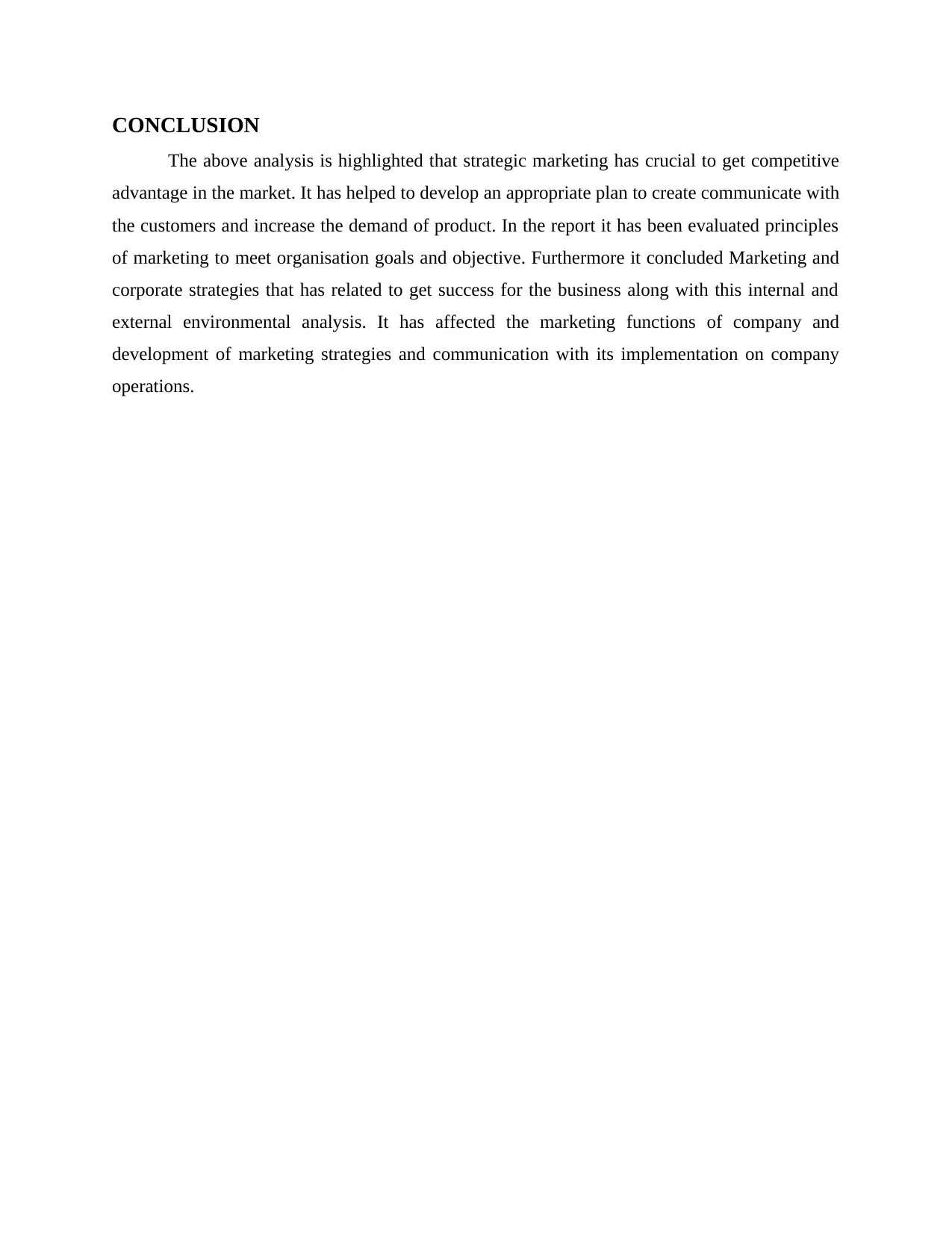
CONCLUSION
The above analysis is highlighted that strategic marketing has crucial to get competitive
advantage in the market. It has helped to develop an appropriate plan to create communicate with
the customers and increase the demand of product. In the report it has been evaluated principles
of marketing to meet organisation goals and objective. Furthermore it concluded Marketing and
corporate strategies that has related to get success for the business along with this internal and
external environmental analysis. It has affected the marketing functions of company and
development of marketing strategies and communication with its implementation on company
operations.
The above analysis is highlighted that strategic marketing has crucial to get competitive
advantage in the market. It has helped to develop an appropriate plan to create communicate with
the customers and increase the demand of product. In the report it has been evaluated principles
of marketing to meet organisation goals and objective. Furthermore it concluded Marketing and
corporate strategies that has related to get success for the business along with this internal and
external environmental analysis. It has affected the marketing functions of company and
development of marketing strategies and communication with its implementation on company
operations.
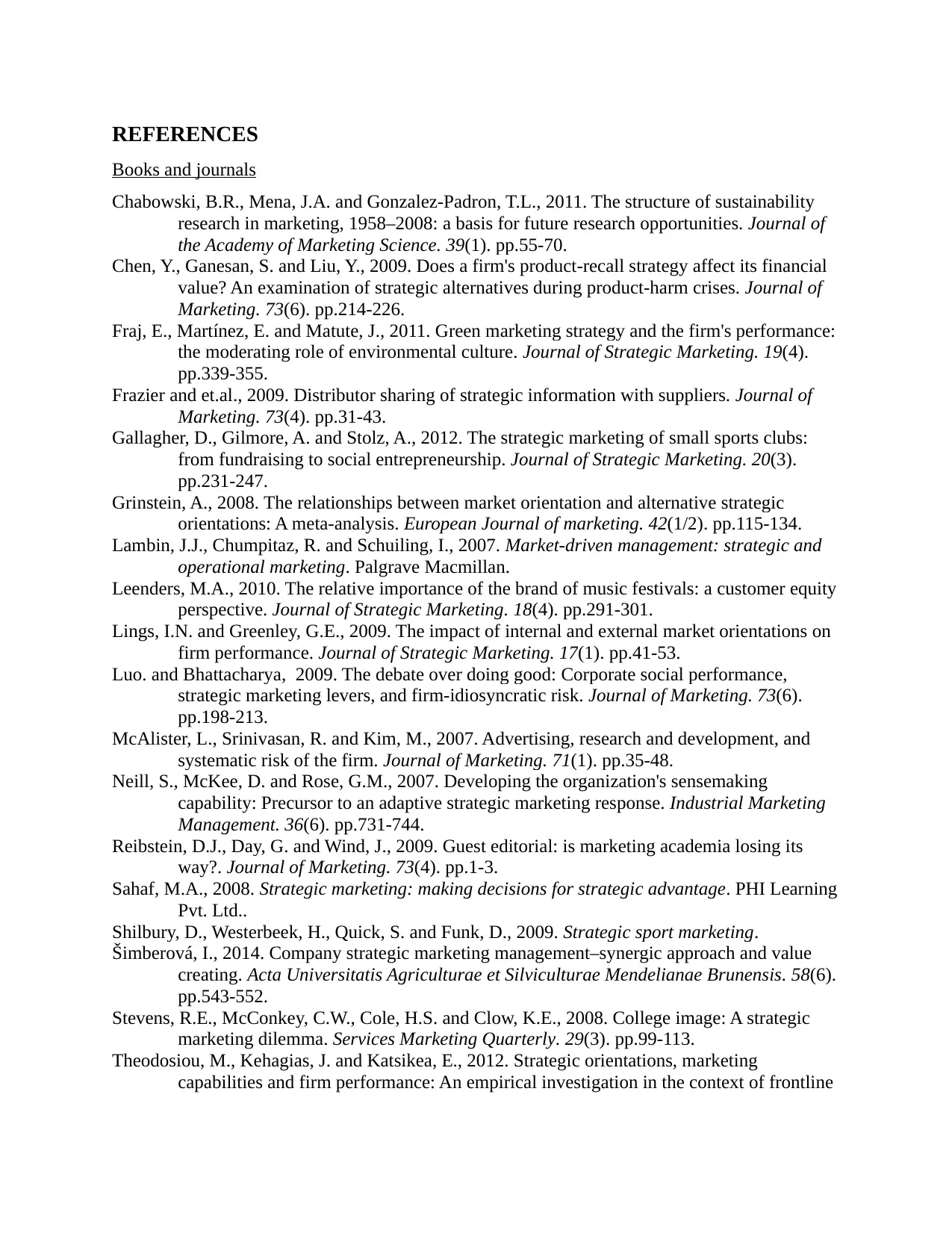
REFERENCES
Books and journals
Chabowski, B.R., Mena, J.A. and Gonzalez-Padron, T.L., 2011. The structure of sustainability
research in marketing, 1958–2008: a basis for future research opportunities. Journal of
the Academy of Marketing Science. 39(1). pp.55-70.
Chen, Y., Ganesan, S. and Liu, Y., 2009. Does a firm's product-recall strategy affect its financial
value? An examination of strategic alternatives during product-harm crises. Journal of
Marketing. 73(6). pp.214-226.
Fraj, E., Martínez, E. and Matute, J., 2011. Green marketing strategy and the firm's performance:
the moderating role of environmental culture. Journal of Strategic Marketing. 19(4).
pp.339-355.
Frazier and et.al., 2009. Distributor sharing of strategic information with suppliers. Journal of
Marketing. 73(4). pp.31-43.
Gallagher, D., Gilmore, A. and Stolz, A., 2012. The strategic marketing of small sports clubs:
from fundraising to social entrepreneurship. Journal of Strategic Marketing. 20(3).
pp.231-247.
Grinstein, A., 2008. The relationships between market orientation and alternative strategic
orientations: A meta-analysis. European Journal of marketing. 42(1/2). pp.115-134.
Lambin, J.J., Chumpitaz, R. and Schuiling, I., 2007. Market-driven management: strategic and
operational marketing. Palgrave Macmillan.
Leenders, M.A., 2010. The relative importance of the brand of music festivals: a customer equity
perspective. Journal of Strategic Marketing. 18(4). pp.291-301.
Lings, I.N. and Greenley, G.E., 2009. The impact of internal and external market orientations on
firm performance. Journal of Strategic Marketing. 17(1). pp.41-53.
Luo. and Bhattacharya, 2009. The debate over doing good: Corporate social performance,
strategic marketing levers, and firm-idiosyncratic risk. Journal of Marketing. 73(6).
pp.198-213.
McAlister, L., Srinivasan, R. and Kim, M., 2007. Advertising, research and development, and
systematic risk of the firm. Journal of Marketing. 71(1). pp.35-48.
Neill, S., McKee, D. and Rose, G.M., 2007. Developing the organization's sensemaking
capability: Precursor to an adaptive strategic marketing response. Industrial Marketing
Management. 36(6). pp.731-744.
Reibstein, D.J., Day, G. and Wind, J., 2009. Guest editorial: is marketing academia losing its
way?. Journal of Marketing. 73(4). pp.1-3.
Sahaf, M.A., 2008. Strategic marketing: making decisions for strategic advantage. PHI Learning
Pvt. Ltd..
Shilbury, D., Westerbeek, H., Quick, S. and Funk, D., 2009. Strategic sport marketing.
Šimberová, I., 2014. Company strategic marketing management–synergic approach and value
creating. Acta Universitatis Agriculturae et Silviculturae Mendelianae Brunensis. 58(6).
pp.543-552.
Stevens, R.E., McConkey, C.W., Cole, H.S. and Clow, K.E., 2008. College image: A strategic
marketing dilemma. Services Marketing Quarterly. 29(3). pp.99-113.
Theodosiou, M., Kehagias, J. and Katsikea, E., 2012. Strategic orientations, marketing
capabilities and firm performance: An empirical investigation in the context of frontline
Books and journals
Chabowski, B.R., Mena, J.A. and Gonzalez-Padron, T.L., 2011. The structure of sustainability
research in marketing, 1958–2008: a basis for future research opportunities. Journal of
the Academy of Marketing Science. 39(1). pp.55-70.
Chen, Y., Ganesan, S. and Liu, Y., 2009. Does a firm's product-recall strategy affect its financial
value? An examination of strategic alternatives during product-harm crises. Journal of
Marketing. 73(6). pp.214-226.
Fraj, E., Martínez, E. and Matute, J., 2011. Green marketing strategy and the firm's performance:
the moderating role of environmental culture. Journal of Strategic Marketing. 19(4).
pp.339-355.
Frazier and et.al., 2009. Distributor sharing of strategic information with suppliers. Journal of
Marketing. 73(4). pp.31-43.
Gallagher, D., Gilmore, A. and Stolz, A., 2012. The strategic marketing of small sports clubs:
from fundraising to social entrepreneurship. Journal of Strategic Marketing. 20(3).
pp.231-247.
Grinstein, A., 2008. The relationships between market orientation and alternative strategic
orientations: A meta-analysis. European Journal of marketing. 42(1/2). pp.115-134.
Lambin, J.J., Chumpitaz, R. and Schuiling, I., 2007. Market-driven management: strategic and
operational marketing. Palgrave Macmillan.
Leenders, M.A., 2010. The relative importance of the brand of music festivals: a customer equity
perspective. Journal of Strategic Marketing. 18(4). pp.291-301.
Lings, I.N. and Greenley, G.E., 2009. The impact of internal and external market orientations on
firm performance. Journal of Strategic Marketing. 17(1). pp.41-53.
Luo. and Bhattacharya, 2009. The debate over doing good: Corporate social performance,
strategic marketing levers, and firm-idiosyncratic risk. Journal of Marketing. 73(6).
pp.198-213.
McAlister, L., Srinivasan, R. and Kim, M., 2007. Advertising, research and development, and
systematic risk of the firm. Journal of Marketing. 71(1). pp.35-48.
Neill, S., McKee, D. and Rose, G.M., 2007. Developing the organization's sensemaking
capability: Precursor to an adaptive strategic marketing response. Industrial Marketing
Management. 36(6). pp.731-744.
Reibstein, D.J., Day, G. and Wind, J., 2009. Guest editorial: is marketing academia losing its
way?. Journal of Marketing. 73(4). pp.1-3.
Sahaf, M.A., 2008. Strategic marketing: making decisions for strategic advantage. PHI Learning
Pvt. Ltd..
Shilbury, D., Westerbeek, H., Quick, S. and Funk, D., 2009. Strategic sport marketing.
Šimberová, I., 2014. Company strategic marketing management–synergic approach and value
creating. Acta Universitatis Agriculturae et Silviculturae Mendelianae Brunensis. 58(6).
pp.543-552.
Stevens, R.E., McConkey, C.W., Cole, H.S. and Clow, K.E., 2008. College image: A strategic
marketing dilemma. Services Marketing Quarterly. 29(3). pp.99-113.
Theodosiou, M., Kehagias, J. and Katsikea, E., 2012. Strategic orientations, marketing
capabilities and firm performance: An empirical investigation in the context of frontline
⊘ This is a preview!⊘
Do you want full access?
Subscribe today to unlock all pages.

Trusted by 1+ million students worldwide
1 out of 13
Related Documents
Your All-in-One AI-Powered Toolkit for Academic Success.
+13062052269
info@desklib.com
Available 24*7 on WhatsApp / Email
![[object Object]](/_next/static/media/star-bottom.7253800d.svg)
Unlock your academic potential
Copyright © 2020–2025 A2Z Services. All Rights Reserved. Developed and managed by ZUCOL.




